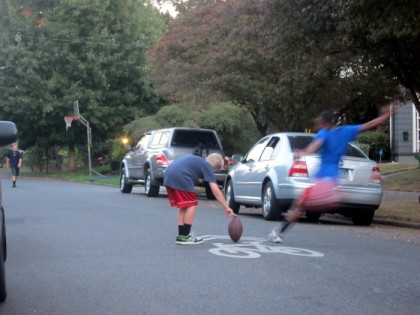
key role in the bill’s passage.
(Photo © J. Maus/BikePortland)
A new state law signed Tuesday will let Oregon cities name narrow side streets where, for the first time in decades, people on foot won’t be required to yield the roadway to drivers.
The bipartisan bill sailed through the statehouse this spring with backing from the City of Portland, the League of Oregon Cities and advocacy group Oregon Walks.
“The law is the first of its kind in the nation,” Portland pedestrian coordinator April Bertlesen wrote in a celebratory email Wednesday.
“When I was young… we would walk side by side, which technically is not lawful. But when you’re eight, you’re going to hold your grandma’s hand.”
— Stephanie Routh, Oregon Walks
“It memorializes in law what Oregonians have come to do on their home streets anyway,” Oregon Walks Director Steph Routh said Thursday in an interview. “When I was young and visiting my grandparents in Wheeler, Oregon, we would walk side by side, which technically is not lawful. But when you’re eight, you’re going to hold your grandma’s hand.”
According to Ray Thomas, a local lawyer and expert on walking laws, “The old law gave no legal standing to pedestrians in the roadway relative to motor traffic and required them to always yield the right of way unless in a crosswalk.”
The new law, which cities will be able to apply only on residential streets that are no more than 18 feet from shoulder to shoulder, requires signs alerting road users that pedestrians (a term which includes people in wheelchairs and similar mobility devices) may be present. It also forbids pedestrians from creating a “traffic hazard.”
Routh said the new law lets cities legalize many other activities, too – not just transportation.
“I think we can all easily remember a moment in the recent past when we have seen a parent pushing a stroller down the roadway to the corner grocery store, or when we have passed a few kids shooting hoops on a side street,” she said in her testimony prior to its passage.
In general, Routh said Thursday, the new law “looks at narrow residential roadways as places that connect people.”
Though the law extends the humans-welcome spirit of Portland’s neighborhood greenway network, it won’t apply to most neighborhood greenways, which are wider than 18 feet. Routh said that in Portland, it’s likely to be a better fit for narrow and unpaved streets in parts of Southwest and East Portland that were developed when still outside the city limits. In the legislature, the bill’s sponsors were Sen. Ginny Burdick (D-Southwest Portland), Sen. Betsy Johnson (D-Scappoose), Sen. Chuck Thomsen (R-Hood River, whose district extends to Portland’s eastern suburbs), Rep. Carolyn Tomei (D-Milwaukie) and Rep. Chris Gorsek (D-Troutdale).
The City of Portland prioritized the bill as a key part of its “Street by Street” program, a recent effort to help neighborhoods make themselves more pedestrian-friendly without having to find money for sidewalks, which cost $1 million or more per mile to install.
Routh said Oregonians shouldn’t see the bill as an reason not to create better sidewalks or roadways, but rather a reason to look for new ways to design and think about streets where sidewalks are, out of necessity, absent.
“In a financially constrained environment, we can’t assume that we’re going to see sidewalks on every street,” Routh said. “Innovative solutions are needed, and sharing the roadways just makes sense.”

